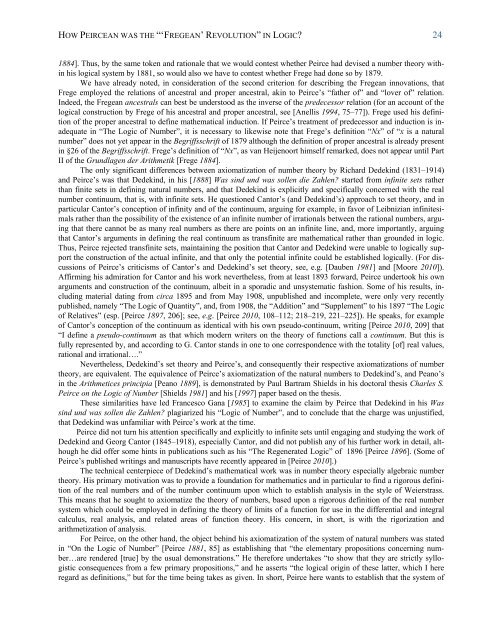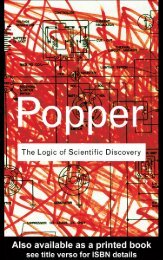You also want an ePaper? Increase the reach of your titles
YUMPU automatically turns print PDFs into web optimized ePapers that Google loves.
HOW PEIRCEAN WAS THE “‘FREGEAN’ REVOLUTION” IN LOGIC? 24<br />
1884]. Thus, by the same token and rationale that we would contest whether Peirce had devised a number theory within<br />
his logical system by 1881, so would also we have to contest whether Frege had done so by 1879.<br />
We have already noted, in consideration of the second criterion for describing the Fregean innovations, that<br />
Frege employed the relations of ancestral and proper ancestral, akin to Peirce’s “father of” and “lover of” relation.<br />
Indeed, the Fregean ancestrals can best be understood as the inverse of the predecessor relation (for an account of the<br />
logical construction by Frege of his ancestral and proper ancestral, see [Anellis 1994, 75–77]). Frege used his definition<br />
of the proper ancestral to define mathematical induction. If Peirce’s treatment of predecessor and induction is inadequate<br />
in “The Logic of Number”, it is necessary to likewise note that Frege’s definition “Nx” of “x is a natural<br />
number” does not yet appear in the Begriffsschrift of 1879 although the definition of proper ancestral is already present<br />
in §26 of the Begriffsschrift. Frege’s definition of “Nx”, as van Heijenoort himself remarked, does not appear until Part<br />
II of the Grundlagen der Arithmetik [Frege 1884].<br />
The only significant differences between axiomatization of number theory by Richard Dedekind (1831–1914)<br />
and Peirce’s was that Dedekind, in his [1888] Was sind und was sollen die Zahlen? started from infinite sets rather<br />
than finite sets in defining natural numbers, and that Dedekind is explicitly and specifically concerned with the real<br />
number continuum, that is, with infinite sets. He questioned Cantor’s (and Dedekind’s) approach to set theory, and in<br />
particular Cantor’s conception of infinity and of the continuum, arguing for example, in favor of Leibnizian infinitesimals<br />
rather than the possibility of the existence of an infinite number of irrationals between the rational numbers, arguing<br />
that there cannot be as many real numbers as there are points on an infinite line, and, more importantly, arguing<br />
that Cantor’s arguments in defining the real continuum as transfinite are mathematical rather than grounded in logic.<br />
Thus, Peirce rejected transfinite sets, maintaining the position that Cantor and Dedekind were unable to logically support<br />
the construction of the actual infinite, and that only the potential infinite could be established logically. (For discussions<br />
of Peirce’s criticisms of Cantor’s and Dedekind’s set theory, see, e.g. [Dauben 1981] and [Moore 2010]).<br />
Affirming his admiration for Cantor and his work nevertheless, from at least 1893 forward, Peirce undertook his own<br />
arguments and construction of the continuum, albeit in a sporadic and unsystematic fashion. Some of his results, including<br />
material dating from circa 1895 and from May 1908, unpublished and incomplete, were only very recently<br />
published, namely “The Logic of Quantity”, and, from 1908, the “Addition” and “Supplement” to his 1897 “The Logic<br />
of Relatives” (esp. [Peirce 1897, 206]; see, e.g. [Peirce 2010, 108–112; 218–219, 221–225]). He speaks, for example<br />
of Cantor’s conception of the continuum as identical with his own pseudo-continuum, writing [Peirce 2010, 209] that<br />
“I define a pseudo-continuum as that which modern writers on the theory of functions call a continuum. But this is<br />
fully represented by, and according to G. Cantor stands in one to one correspondence with the totality [of] real values,<br />
rational and irrational….”<br />
Nevertheless, Dedekind’s set theory and Peirce’s, and consequently their respective axiomatizations of number<br />
theory, are equivalent. The equivalence of Peirce’s axiomatization of the natural numbers to Dedekind’s, and Peano’s<br />
in the Arithmetices principia [Peano 1889], is demonstrated by Paul Bartram Shields in his doctoral thesis Charles S.<br />
Peirce on the Logic of Number [Shields 1981] and his [1997] paper based on the thesis.<br />
These similarities have led Francesco Gana [1985] to examine the claim by Peirce that Dedekind in his Was<br />
sind und was sollen die Zahlen? plagiarized his “Logic of Number”, and to conclude that the charge was unjustified,<br />
that Dedekind was unfamiliar with Peirce’s work at the time.<br />
Peirce did not turn his attention specifically and explicitly to infinite sets until engaging and studying the work of<br />
Dedekind and Georg Cantor (1845–1918), especially Cantor, and did not publish any of his further work in detail, although<br />
he did offer some hints in publications such as his “The Regenerated Logic” of 1896 [Peirce 1896]. (Some of<br />
Peirce’s published writings and manuscripts have recently appeared in [Peirce 2010].)<br />
The technical centerpiece of Dedekind’s mathematical work was in number theory especially algebraic number<br />
theory. His primary motivation was to provide a foundation for mathematics and in particular to find a rigorous definition<br />
of the real numbers and of the number continuum upon which to establish analysis in the style of Weierstrass.<br />
This means that he sought to axiomatize the theory of numbers, based upon a rigorous definition of the real number<br />
system which could be employed in defining the theory of limits of a function for use in the differential and integral<br />
calculus, real analysis, and related areas of function theory. His concern, in short, is with the rigorization and<br />
arithmetization of analysis.<br />
For Peirce, on the other hand, the object behind his axiomatization of the system of natural numbers was stated<br />
in “On the Logic of Number” [Peirce 1881, 85] as establishing that “the elementary propositions concerning number…are<br />
rendered [true] by the usual demonstrations.” He therefore undertakes “to show that they are strictly syllogistic<br />
consequences from a few primary propositions,” and he asserts “the logical origin of these latter, which I here<br />
regard as definitions,” but for the time being takes as given. In short, Peirce here wants to establish that the system of





